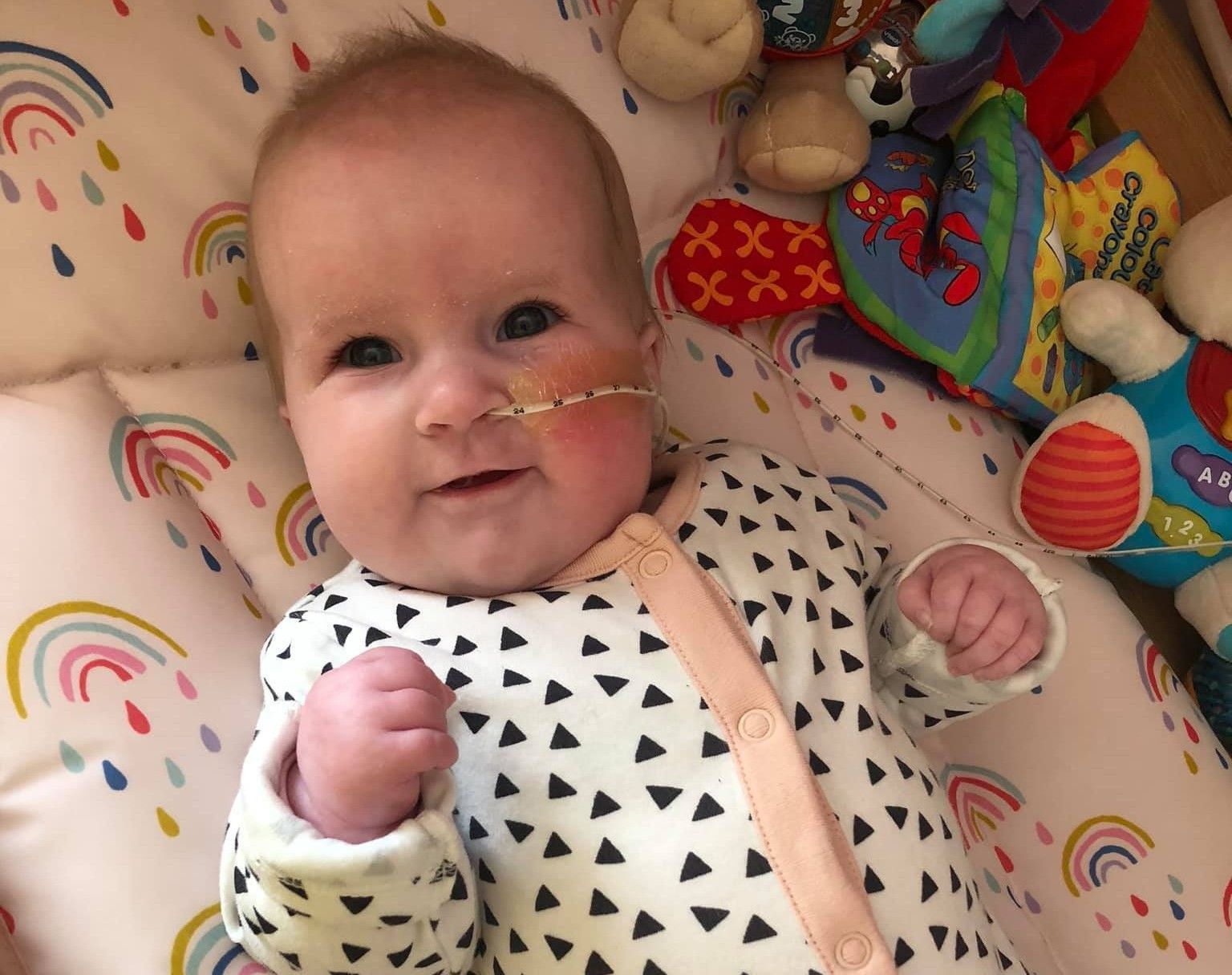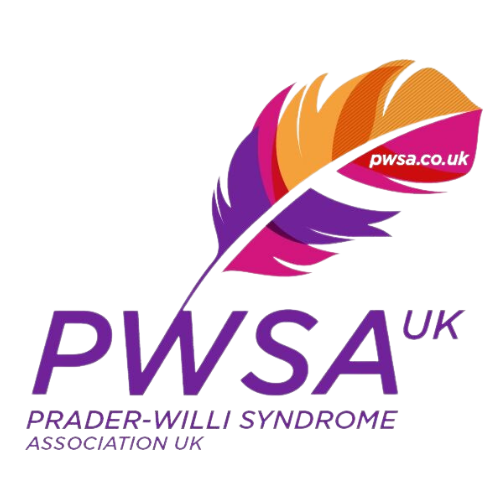Are you getting the right care?
PWS is a rare and complex condition requiring lifelong specialist care from many different professionals.
To make sure everyone understands how to manage PWS in the most effective way possible, a team of expert clinicians have produced these
best practice guidelines.
As carers, we can use these guidelines to ensure our loved ones are receiving appropriate care in accordance with the latest research and evidence.
We have summarised the guidance by topic here, but if you need to direct clinicians to the guidelines, you should refer them to the full published article.
It's important to remember, this guidance refers to a list of conditions that can occur in people with PWS. Every person with PWS is different and many people only experience a handful of these.
Early Feeding

In their first year, children with PWS typically take a long time to feed and swallow.
Management guidance:
Difficulty swallowing can be unsafe and is managed by using a tube from the nose to the stomach (nasogastric tube) to help with food and medicine for at least 2-3 months.
Feeding difficulties often ease as the child grows older, before issues with over-eating begin.
To prevent overeating or under-eating, specialists will help determine the amounts of food the child should be consuming and monitor growth in height and weight.
Hyperphagia (over-eating) and Obesity
Problems with over-eating and having poor control over hunger usually develop between 3-8 years old but can also develop later.
Over-eating puts children with PWS at risk of severe obesity unless their food intake is controlled.
Management guidelines:
Dietary advice from a professional is advised upon diagnosis with PWS.
Hyperphagia means that all food in the child’s environment needs to be managed in a consistent way so that the child is not tempted or confused by inconsistencies.
This is known as food security and is important for the child at home, in nurseries and schools.
Most children with PWS like a routine and therefore, providing clear mealtimes and routines from an early age can make it easier for implementing food control plans. Irregular access to food or specific types of food can trigger behaviour problems. It’s therefore important to have planned mealtimes that are shared together, and siblings’ needs should be planned as part of these routines.
Nutrition and Dietary Management
From a young age (2-4 years) children with PWS need fewer calories than their peers (often around 30% less. ie 70% of usual diet).
Management guidelines:
It is essential to establish good eating habits and have controlled access to food during early childhood.
Children require a very healthy balanced diet, with reduction of portion sizes.
A diet with plenty of vegetables, fish and lean meat, and without unhealthy snacks, sugary drinks, and ready-made meals, is recommended.
Guidance on food should be provided by the lead PWS paediatrician and an experienced dietitian, and more information can be found at https://www.pwsa.co.uk/dietary-management.
Vitamins and Supplements

Due to restrictions on diet, age-appropriate vitamin and mineral supplements are recommended, either prescribed or over the counter.
Management guidelines:
Blood tests to assess the nutrient levels should be performed yearly.
Whilst some centres outside the UK and Ireland suggest the use of supplements such as medium-chain triglycerides (MCT), coenzyme Q10, and carnitine, there is little or no evidence to support these in PWS and they are expensive, and so routine use is not recommended.
Sleep Apnoea and Breathing Difficulties

Sleep apnoea is often experienced by children with PWS. This is when breathing pauses for longer than usual during sleep. There are two types of sleep apnoea: central (brain does not give a signal to breathe) and obstructive (obstruction of airways). Sleep apnoea occurs mainly in very young children but can last or start at later age, especially if the child is over-weight.
Management guidelines:
When a child is diagnosed with PWS they should have a Level 2 sleep study. This measures heart and breathing rates, and oxygen and carbon dioxide levels during sleep. Growth Hormone (GH) treatment (described in detail below) can occasionally worsen obstructive sleep apnoea so a sleep study is required before starting this treatment.
Depending on the type of sleep apnoea further advice will be given before starting GH treatment. Central apnoea should not delay starting GH treatment whereas, obstructive will need treatment before starting GH. A respiratory team will work on treatment of both types of sleep apnoea. For obstructive apnoea some children will need oxygen or a breathing mask which delivers pressure to open the airways (CPAP) recommended by the respiratory team.
Growth Hormone Treatment
Growth hormone (GH) treatment helps to maintain healthy body composition in people with PWS by increasing muscle mass and reducing fat. Treatment may also improve movement and overall development.
This treatment would be supervised by a specialist (a paediatric endocrinologist) who recommends doses based on multiple measurements.
Management guidelines:
After completion of a Level 2 sleep study and receiving respiratory team advice (see above), growth hormone treatment may be recommended. This is usually started by the time the child is 12 months old.
At every clinic visit, height and weight are measured to calculate BMI and growth rate. This is compared to standard child growth charts.
GH treatment is usually ended when growth ends (before/ between 13-18 years old), but in some cases can continue until the age of 25 if a person had a lack of GH (a GH deficiency) following specific guidelines.
A GH deficiency occurs in 40-100% of patients with PWS which may require long term treatment. More information on GH treatment and deficiency with recommendations on treatment into adulthood can be found within the extended guidance article: https://doi.org/10.1530/EC-24-0091.
In PWS patients with severe obesity and/or a lot of weight gain, starting GH therapy may not be recommended as it can make other symptoms worse. This includes patients with untreated or poorly managed obstructive sleep apnoea (breathing difficulties), poorly controlled type 2 diabetes mellitus (T2DM), high blood pressure, and other obesity-related complications. Once these complications are being treated and under management then GH treatment can be re-considered.
Low Cortisol
Recent studies have suggested that lack of cortisol ‘stress’ hormone in children with PWS is rare (1-2%).
Management guidelines:
In the UK and Ireland, testing for low levels of cortisol stress hormone is only recommended if there are specific symptoms that indicate this or associated complications. If there are concerns about possible low levels of cortisol, around the time of surgery where the patient is put to sleep, an assessment will be performed.
Hypothyroidism (Low thyroid hormone)
Low thyroid hormone and thyroid dysfunction can occur in people with PWS.
Management guidelines:
Yearly monitoring of thyroid function by a blood test is suggested and treatment can be started if this shows that thyroid hormone levels are lower than normal.
Puberty and Sexual Maturity
Sex and regulatory hormones from the hypothalamus (area of the brain involved in hormone regulation) can be low in PWS (known as hypogonadism).
This can affect multiple factors including: the drop of the testes before birth in boys, puberty, and the levels of sex hormones testosterone and oestrogen.
Early development of pubic and underarm hair is common in PWS and does not usually require treatment.
Management guidelines:
Hormone replacement treatment can be used to help with puberty, for long-term health, bone strength and heart/circulatory health.
An endocrinologist will assess whether treatment with sex hormones (testosterone for boys, oestrogen for girls) is needed through blood tests and assessing the child’s development into puberty. Testosterone and oestrogen treatment is available in several forms (testosterone gel, injections, oestrogen tablets or plasters). The full guidelines article contains examples of preparations that may be used https://doi.org/10.1530/EC-24-0091.
In boys if the testes have not dropped, surgery is needed to move the testes into the scrotum. Due to small testes size and difficulty with surgery in children with PWS, this is performed in a specialist centre and often delayed (around or after age 1) to improve outcomes. There is currently not enough evidence to recommend hormone treatment for treating testes that have not dropped.
In females, fertility is rare in PWS, but a few pregnancies have been reported. Male fertility has not been reported. Fertility, contraception, and sexual health should be discussed professionally at an appropriate age with the child.
There is a 50% chance that pregnancy in women with PWS may result in a child affected with Angelman Syndrome (a rare genetic condition that affects the nervous system and causes severe physical and learning disabilities).
The PWSA UK has produced these animated videos specially for people with PWS about puberty and sexual development.
Muscle Tone
PWS causes low muscle strength, muscle tone and unstable joints (especially in the ankles). Children with PWS can get tired more easily and are less active. A recent medical study showed that regular exercise can benefit patients with PWS to help strengthen muscles, help with weight management, improve circulatory health and improve emotional well-being. To help with exercise supportive shoes are recommended (inserts or splints can help with unstable ankle joints). To encourage children with PWS to exercise, a few strategies have been shown to help such as allowing the child to choose the type of exercise they are doing.
Bone Density and Osteoporosis
Osteoporosis (where bones weaken, making them fragile and more likely to break) can occur early in adults with PWS. This is likely due to the lack of weight-bearing exercise (such as walking, running), low vitamin D and calcium intake, and low levels of sex hormones.
Management guidelines:
To check bone health, bone mineral density (BMD) is usually tested with a DXA scan before transition of PWS patient to adult teams. Hormone replacement therapy (oestregen or testosterone) from puberty can be used help to improve bone density.
Scoliosis (Curve in the spine)
Children with PWS should be examined yearly to look for curves in their spines (scoliosis). This can occur in over 40% of children with PWS. Parents should also report any changes they notice to a specialist. X-rays to assess the spine are recommended from when the child is able to sit independently and are repeated every 2 years until age 5, and then repeated every 2 years from the age of 10 years until the end of growth. Depending on the severity of curvature of the spine, further treatments may be needed such as bracing or surgery. Sometimes, children can develop a frontal curve and advice from a physiotherapy on posture, muscle strengthening and seating can be helpful. It is important to encourage fitness and maintain muscle strength and posture for spinal health throughout life.
Stomach Issues
Gastric rupture (a hole in the stomach or small intestine) due to overeating or slow stomach emptying can occur in PWS. This can be life threatening and requires emergency medical treatment.
Symptoms can include vomiting, which is otherwise rare, abdominal pain, and occasionally haematemesis (vomiting blood).
Gastroesophageal reflux (GOR) is a repeated burning feeling in the chest caused by stomach acid travelling up towards the throat which can be more common in children with PWS. GOR can lead to liquid being sucked into the lungs and it is important to recognise and treat GOR.
Choking on food is a risk in PWS. Fast eating and not having enough to drink with solid food may contribute to this and should be monitored.
Constipation
Constipation has been reported in both children and adults with PWS.
Management guidelines:
- Probiotics (such as Biokult©) can be helpful for managing constipation and abdominal bloating.
- Encouraging a good fluid intake is important to help avoid constipation.
- Lactulose should be avoided as a laxative because of the risk of bacterial overgrowth with gut dysmotility in neurodevelopmental disorders.
Developmental Delay
In early years it is common for children to have delayed movement (crawling/walking).
The development of speech, language, interactions, play and learning can vary between each child.
Management guidelines:
- Children with PWS should be under the care of their local Child Developmental Centre (CDC) or team (CDT).
- A physiotherapist should provide advice with dealing with floppiness and delayed movement during the early months and years of development to help with crawling and walking.
- A speech therapist can help with advice on swallowing, safety of feeding and later on if there is a delay in learning to talk.
- An occupational therapist will provide advice if there is difficulty with hand skills, self-care (eating, drinking, brushing teeth, going to the toilet), sensory issues (such as dislike of loud environments, bright lights or intense smells or sensations of touch), co-ordination or a need for adapted seating.
Social Communication and Neurodiversity
PWS can often cause difficulties with understanding interactions with other people, narrowed focus of interest, repetition, getting stuck on an issue, controlling emotions and skin picking.
Many children with PWS therefore have some of the difficulties seen in Autism Spectrum Conditions and can also be diagnosed with Autism. It’s not clear how many children with PWS also have Autism which means assessments for Autism are needed throughout development.
Learning Disability
General difficulties with learning and ability to think/understand ideas or information is usually in the mild to moderate range for children with PWS.
There are specific difficulties with learning that are common in children with PWS. This includes the speed of understanding spoken information and replying, switching between activities and short-term memory.
Management guidelines:
- It is possible to adapt teaching to accommodate for these issues.
- Issues such as sleepiness and distraction about food can also make learning more difficult.
- This information will need to be given to a child’s school by a community paediatrician and other specialists when needed to help with education.
- Some children will be able to manage at a mainstream school with additional support and then move to a special school as they get older. Other children may be better going to a special school from a younger age.
Mental Health and Behaviour
Behavioural issues in PWS can include stubbornness, temper outbursts and obsessive-compulsive tendencies.
Skin picking, repetitive questioning, transition difficulty, and non-compliance are the most commonly reported problematic behaviours.
There is also higher risk of developing mental health disorders, most commonly anxiety.
More serious mental health conditions such as psychosis have been reported, particularly around adolescence and young adulthood.
All of these conditions can be challenging and require specialised advice and support from mental health professionals with experience in dealing with PWS.
Management guidelines:
Problematic behaviours can be triggered by food-related issues, and sometimes managed through control of the food environment and a consistent day-to-day regime.
Referrals to Child and Adolescent Mental Health Services (CAMHS) or learning disability teams may be necessary but detailed explanation about PWS will be needed to these teams from the specific paediatricians treating the child to get specialised support.
Skin Picking and Rectal Picking
Skin picking is frequently reported in PWS. This can lead to cuts and grazes taking a long time to heal and becoming infected. In extreme cases Sepsis secondary to skin ulceration has been known to develop and be fatal in older people with PWS.
Rectal picking:
Patients with PWS may also display rectal picking, which may lead to ulceration and rectal bleeding, masquerading as inflammatory bowel disease (218). Treatment for this is difficult and is mostly based on tools for behavioural change although mainstream treatment of constipation is also paramount.
Management guidelines:
Keeping nails short and using moisturisers, covering minor skin lesions, together with distraction techniques may help to reduce this in the first instance.
Identifying the circumstances in which skin picking happens, such as boredom, lack of engagement, and anxiety, may contribute to developing preventative strategies.
Several medications have been trialled for skin picking but there has been limited success. You might hear people talking about N-acetylcysteine, which has shown some success in one study. More details on this are available in the full guidance document.
Eyesight
Eye and vision problems are frequent in PWS, with most identified before the age of 5 years. Squint (sometimes called Strabismus) where the eyes can point in different directions is probably related to muscle problems and is the most common.
Management guidelines:
It is important that children with PWS are screened for visual problems and that these are corrected early on. Treatment for strabismus including surgery may be required.
Dental Issues
People with PWS produce less saliva and it is more viscous (sticky). This can increase the risk of tooth decay and cavities.
Management guidelines:
People with PWS should have regular dental reviews to spot and treat signs of decay quickly.
Transition to Adult Care
Transitioning to adult health and care services should involve referral and coordination by the lead PWS paediatrician, PWS clinic or endocrinologist.
Discussions on mental capacity legislation, which applies from the age of 16, will be needed especially in relation to food, money and concept of partial mental capacity.

